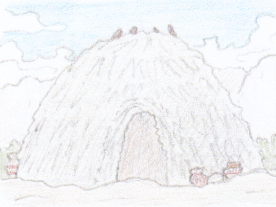Taxótans
Ynamok: Taxótám /taksouthauːm/
The taxótans1 are various tribes native to the Talax Mountains in northeastern Túlmikkía, some of which are subjects of the empire of Ænadó.
When Enans came from distant Emlas across the sea to the west and established colonies along the coast, many of the lowland taxótans made alliances with the different colonies, fighting off hostile tribes in exchange for goods, and adopted more sedentary lifestyle. This continued after the fall of the enan mother cities and subsequent wars between the colonies until the founding of Ænadó, after which the lowland -and later on the north- and central highland- tribes became subjects of the new empire.
Some taxótans settled down in southern Laxilþía across the sea to the northwest as the Ænateans established their own colonies there, though their descendants have since been absorbed into rexan culture after the region was conquered by the empire of Resak.
Traditionally, most tribes practice matrilocal residence, as in men are expected to live with their wife's family, and a taxótan's status within their tribe is inherited through their mother. The leader of each tribe is usually a man, though woman chiefs are not unusual.
Tattoos and body-paint are common, characterized by zigzag or wavy patterns, though ænatean styles are common among lowland taxótans.
Long hair, either braided or divided using small, golden or carved bone rings, is popular among men and women alike, and men often sport long beards.
The taxótans1 are various tribes native to the Talax Mountains in northeastern Túlmikkía, some of which are subjects of the empire of Ænadó.
History
Taxótans were originally the dominant culture in northeastern Túlmikkía, both in the mountains and along the coast, subsisting mostly on hunting, fishing and gathering along with limited agriculture, focused on peanuts, tomatoes and pineapples and -along the Júmsa River- raising pigeons for food.When Enans came from distant Emlas across the sea to the west and established colonies along the coast, many of the lowland taxótans made alliances with the different colonies, fighting off hostile tribes in exchange for goods, and adopted more sedentary lifestyle. This continued after the fall of the enan mother cities and subsequent wars between the colonies until the founding of Ænadó, after which the lowland -and later on the north- and central highland- tribes became subjects of the new empire.
Some taxótans settled down in southern Laxilþía across the sea to the northwest as the Ænateans established their own colonies there, though their descendants have since been absorbed into rexan culture after the region was conquered by the empire of Resak.
Society
Most taxótans outside Ænadó either live in tents or domed shelters made of wooden frame covered in reed- or bark mats (similar to our world's wigwams), with the former being more common among hunter-gatherers and the latter among farmers.Traditionally, most tribes practice matrilocal residence, as in men are expected to live with their wife's family, and a taxótan's status within their tribe is inherited through their mother. The leader of each tribe is usually a man, though woman chiefs are not unusual.
Culture
Apparel
Traditional taxótan clothing consists of simple loincloths for men, particularly warriors, and wide, sleeveless, unbelted tunics for women, though men sometimes wear similar though shorter tunics as well, all of which are preferably dyed red. Originally made from animal skins or pineapple fibers, wool has become the material of choice. Bracelets and anklets made from shells, bone or glass beads are common.Tattoos and body-paint are common, characterized by zigzag or wavy patterns, though ænatean styles are common among lowland taxótans.
Long hair, either braided or divided using small, golden or carved bone rings, is popular among men and women alike, and men often sport long beards.









Comments